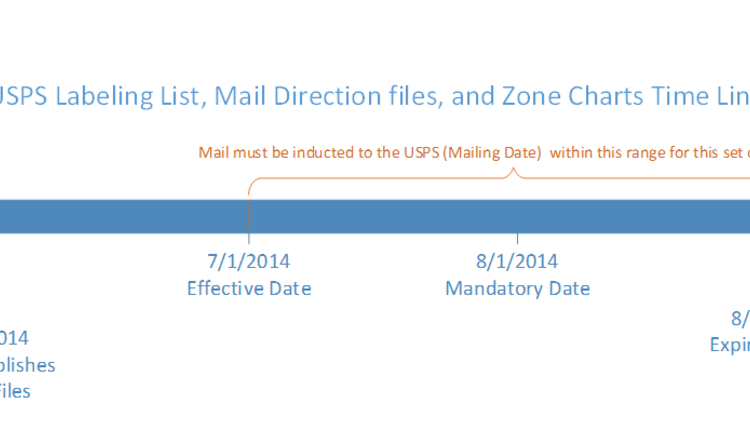Once again, the United States Postal Service is back to requiring Intelligent Mail barcodes, and this time, it is drawing two lines in the sand. The first is the retirement of the POSTNET barcode and the requirement of the basic Intelligent Mail barcode in January 2013. Simply put, if you do not have an Intelligent Mail barcode on your mailpiece come January 2013, you will not be able to claim automation discounted postage rates.
The second line in the sand is January 2014, when the USPS will require Full Service Intelligent Mail barcodes and, along with them, the requirement for unique container identification, electronic documentation, 45-day unique piece serial numbers, and a host of other requirements. While many mailers seem ready for the January 2013 requirement due to the USPS attempting its forced implementation several years ago, quite a few mailers are voicing concerns that they will not be ready for Full Service IMb in 2014. Or are they actually ready for Full Service IMb now?
Software is an essential component to Intelligent Mail barcodes, and many of the software solution providers have been working closely with the USPS for well over a decade on Intelligent Mail. It may surprise many software users how much support for Intelligent Mail already exists in the software they have.
Let's Look at an Example
Consider, for example, the unique serial number requirement for Full Service IMb. In many ways, this is arguably the most critical component for the USPS in the IMb as it forms the backbone of its service performance and visibility commitment to its customers and what is required under the Postal Accountability and Enhancement Act. With unique serial numbers on all automation-compatible mailpieces, the USPS will have unprecedented visibility into the world's largest postal delivery network. Prior to IMb, service standards were largely inferred from various tracking methodologies. However, with Full Service IMb, the USPS will be able to "see" the mail being processed in new and critical ways. Moreover, mailpiece visibility also supports multi-channel marketing - an important and growing way for savvy marketers to reach new customers.
Does your current software solution provide unique serial numbers? Most likely, yes. Many software solutions have starting sequence numbers that can be reset manually or automatically to ensure 45-day uniqueness by mailer identification. Moreover, some solution providers also offer tracking services either directly or with partners to provide piece and container-level visibility.
The second significant requirement for Full Service IMb is electronic documentation. The driver behind this requirement is for the USPS to reduce labor costs during mail acceptance by eliminating paper postage statements. It also provides the ability for the USPS to determine what is known as the "by-for relationship." The "by-for relationship" identifies the mail owner, mail preparer, and postage payer. Electronic documentation involves submitting a data file into PostalOne! or manually entering postage statement information into the USPS Postage Statement Wizard.
There are currently three different ways software solutions support electronic documentation today. The first is simply facilitating the use of the USPS Postage Statement Wizard. The software generates the postage statement and the user simply keys the information into the Postage Wizard page. For mailings of 10,000 pieces or fewer, this is likely the easiest and most cost-effective way to comply with this required component of Full Service IMb.
For mailings larger than 10,000 pieces, the IDEAlliance association, a not-for-profit organization in the information technology and publishing fields, has developed and actively supports both the Mail.dat and the Mail.XML file formats to upload postage documentation into PostalOne! Of the two formats, Mail.dat is the most readily available, and indeed dozens of software solution providers have been actively supporting and providing Mail.dat (often at no charge) for decades. Even if your current solution does not have Mail.dat enabled, you may be surprised at the modest investment to do so considering the tremendous time savings it provides in facilitating mail acceptance and payment. Moreover, Mail.dat has numerous other uses in transportation planning and co-mingling.
The final required components for Full Service IMb, such as support for Customer Supplier Agreements, Intelligent Mail package barcode, and Intelligent Mail container barcodes, are also becoming readily available as standard components in presort software solutions. Check with your current solution provider and you might be surprised to find that support for Full Service IMb is already in there today, well in advance of January 2014.
Christopher Lien is Vice President, Software Marketing, Bell and Howell.
The second line in the sand is January 2014, when the USPS will require Full Service Intelligent Mail barcodes and, along with them, the requirement for unique container identification, electronic documentation, 45-day unique piece serial numbers, and a host of other requirements. While many mailers seem ready for the January 2013 requirement due to the USPS attempting its forced implementation several years ago, quite a few mailers are voicing concerns that they will not be ready for Full Service IMb in 2014. Or are they actually ready for Full Service IMb now?
Software is an essential component to Intelligent Mail barcodes, and many of the software solution providers have been working closely with the USPS for well over a decade on Intelligent Mail. It may surprise many software users how much support for Intelligent Mail already exists in the software they have.
Let's Look at an Example
Consider, for example, the unique serial number requirement for Full Service IMb. In many ways, this is arguably the most critical component for the USPS in the IMb as it forms the backbone of its service performance and visibility commitment to its customers and what is required under the Postal Accountability and Enhancement Act. With unique serial numbers on all automation-compatible mailpieces, the USPS will have unprecedented visibility into the world's largest postal delivery network. Prior to IMb, service standards were largely inferred from various tracking methodologies. However, with Full Service IMb, the USPS will be able to "see" the mail being processed in new and critical ways. Moreover, mailpiece visibility also supports multi-channel marketing - an important and growing way for savvy marketers to reach new customers.
Does your current software solution provide unique serial numbers? Most likely, yes. Many software solutions have starting sequence numbers that can be reset manually or automatically to ensure 45-day uniqueness by mailer identification. Moreover, some solution providers also offer tracking services either directly or with partners to provide piece and container-level visibility.
The second significant requirement for Full Service IMb is electronic documentation. The driver behind this requirement is for the USPS to reduce labor costs during mail acceptance by eliminating paper postage statements. It also provides the ability for the USPS to determine what is known as the "by-for relationship." The "by-for relationship" identifies the mail owner, mail preparer, and postage payer. Electronic documentation involves submitting a data file into PostalOne! or manually entering postage statement information into the USPS Postage Statement Wizard.
There are currently three different ways software solutions support electronic documentation today. The first is simply facilitating the use of the USPS Postage Statement Wizard. The software generates the postage statement and the user simply keys the information into the Postage Wizard page. For mailings of 10,000 pieces or fewer, this is likely the easiest and most cost-effective way to comply with this required component of Full Service IMb.
For mailings larger than 10,000 pieces, the IDEAlliance association, a not-for-profit organization in the information technology and publishing fields, has developed and actively supports both the Mail.dat and the Mail.XML file formats to upload postage documentation into PostalOne! Of the two formats, Mail.dat is the most readily available, and indeed dozens of software solution providers have been actively supporting and providing Mail.dat (often at no charge) for decades. Even if your current solution does not have Mail.dat enabled, you may be surprised at the modest investment to do so considering the tremendous time savings it provides in facilitating mail acceptance and payment. Moreover, Mail.dat has numerous other uses in transportation planning and co-mingling.
The final required components for Full Service IMb, such as support for Customer Supplier Agreements, Intelligent Mail package barcode, and Intelligent Mail container barcodes, are also becoming readily available as standard components in presort software solutions. Check with your current solution provider and you might be surprised to find that support for Full Service IMb is already in there today, well in advance of January 2014.
Christopher Lien is Vice President, Software Marketing, Bell and Howell.





